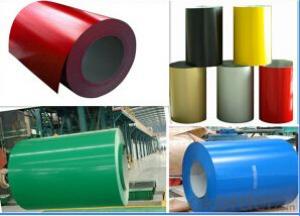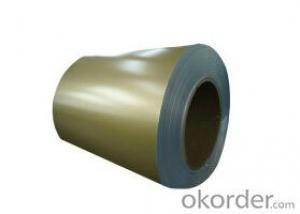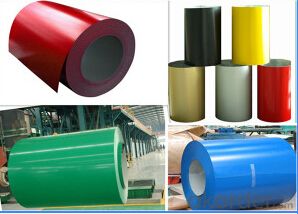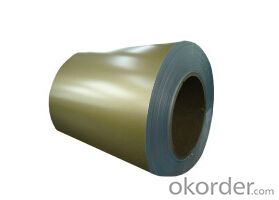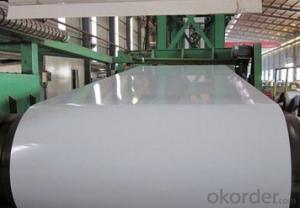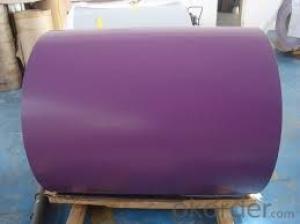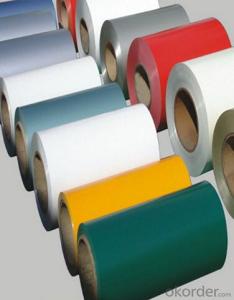Coated Steel, PPGI / Prepainted Galvanized Steel Coil
- Loading Port:
- Tianjin
- Payment Terms:
- TT OR LC
- Min Order Qty:
- 25 m.t.
- Supply Capability:
- 10000 m.t./month
OKorder Service Pledge
OKorder Financial Service
You Might Also Like
Description:
Model NO.:AISI, ASTM, BS, DIN, GB, JIS
Surface Treatment:Coated
Certification:ISO, SGS, BV, Ciq,Bsj
Technique:Cold Rolled
Standard:ASTM, JIS, GB, AISI, DIN, BS
Application:Constructions,Household Appliances,Roofing,etc.
Edge:Slit edge
Stock:Stock
Steel Grade:SPCC/SGCC/Dx51d/Dx52D
Commodity Name:Prepainted Galvanized Steel Coil
Grade:SPCC/SGCC/Dx51d/Dx52D
Thickness:0.16 to 1.00 Mm
Width:600 to 1500 Mm
Zinc Coating:Z 40-275 GSM
Colors:as Per Ral Shades/Customer Requirements.
Color Coating:Top 27+5um Back: 5-7um
Unit Weight:3-10 Ton
MOQ:25mt
Export Markets:Global
Additional Info.
Packing:Seaworthy Pacakge
Standard:SGS, BV, CIQ, BSJ
Origin:China
Production Capacity:5000 Tons Per Month
Product Description
Product Description
CONTENTS | PRODUCT SPECIFICATION | |||||
| Commodity | Prepainted galvanized steel coil | |||||
| Base Metal | Cold rolled, Electro-galvanized base metal, Hot-dip zinc coated base metal, Hot dip Al-Zn steel sheet | |||||
Thickness | 0.16 TO 1.00 mm | |||||
| Width | 600 TO 1500 mm | |||||
| Coil ID | 508 / 610 mm | |||||
| Type | coil/sheet/strips | |||||
Delivery Time | 15-30days after we receive deposit | |||||
Substrate Hardness | Soft, medium,full hard | |||||
| Zinc Coating | Z 40-275 gsm, AZ 40-180 gsm or as customer requirements | |||||
| Types of top coating | PE, Silicon modified polyesters, High-durability polyester, polyvinylidene fluoride | |||||
Colours | As per RAL shades/customer requirements. | |||||
| Surface Finishes | Glossy and Matte | |||||
| Price: | US $600-800 / Metric Ton | |||||
| Slits | 37mm and above | |||||
| Standards | AISI, ASTM, BS, DIN, GB, JIS | |||||
| Transport | By bulk or container | |||||
| Packing | Standard packing or at buyer's requirement | |||||
Applications:
Pre-painted steel metal products are used in a vast array of applications including:
construction industry
household appliances
automotive
industrial applications
packaging
FAQ
1.What's your MOQ?
25MT, it is for one container.
2.Do you have QC teams?
Yeah, sure, our QC team is very important, they will keep the quality control for our products.
3. What's your normal delivery time?
Our delivery time about 10-20days for standard sizes, if you have other requirements like hardness and width ,it is about 20-40days. But don't worry ,we also try our best for the delivery time ,because time longer and our cost is higher.
4.Are the products tested before shipping?
Yes, all of our PPGI and GI was qualified before shipping. We test every batch every day
- Q: What is the cost of a steel coil?
- The cost of a steel coil can vary depending on several factors such as the type of steel, size, weight, and market conditions. It is best to contact a steel supplier or manufacturer for an accurate and up-to-date price quote.
- Q: I am wondering if i can use my western guitar as a kind of steel-guitar, read something about it on Wikipedia.
- If you decide to get a true pedal steel, plan on spending some big money. Look on eBay for a Carter Starter. It will be the best guitar to start on...and not outgrow too fast.
- Q: When steel is cast, does it become weaker/more brittle or anything of this nature? what are the side effects of steel casting on the steel itself?How can you correct these?
- Cast steel uses specific alloys of steel designed to improve the casting process. It has a specific strength and toughness range based on the alloying ingredients. It physical properties are a bit different from rolled steel. The primary problems with casting steel are porosity and voids or spaces where the mold is not completely filled with molten steel. These do not effect the basic strength of the steel but they can degrade the ability of the casting to function as designed.
- Q: Describe and explain how the differences in the properties of the thee main types of steel allow them to be used in different ways. I have some chemistry homework due in for tomorrow (yes I know i left it a bit late but I really don't like chemistry) and I would love it if I could actually at least pretend to my teacher that I know what she's on about this lesson because honestly, I really don't know what she spends so long telling us all. Any help would be appreciated and points for the best answer!
- TYPES OF STEEL: CARBON STEEL ============= Steels containing 0.2% C to 1.5% C are known as carbon steel. They are of three types. Low Carbon Steel It contains 0.2% carbon. Uses: Sheets, wires, pipes. Mild Carbon Steel It contains 0.3% to 0.7% carbon. Uses: Rails, boilers, plates, axles, structures. High Carbon Steel It contains 0.7% to 1.5% carbon. Uses: Surgical instruments, razor blades, cutlery, spring. STAINLESS STEEL =============== It contains 14% to 18% chromium and 7% to 9% nickel. Uses: Car accessories, watch case, utensils, cutlery. ALLOY STEEL ============= There are three types of alloy steel. Mn-Steel It contains 10%-18% Mn. Uses: Rail tracks, armor plate, safe. Si-Steel It contains 1% to 5% Si. Uses: Permanent magnet. Ni-Steel It contains 2% to 4% Ni. Uses: Machine components, Gear, shaft, cable. :) Ref. www.google .in/search?q=wikiso...
- Q: it has 2 be 20 inches overall, and 2and1/2 inches wide and .25 or more inches thick... im thinking truck steel but im not sure thx
- A sawmill blade(circular type) It`s good steel already hardened and you saw out your knife pattern with a skill saw loaded with an abrasive cut-off wheel. Norton wheels are best from Home Depot.
- Q: What dangers were there for the steel workers in Pittsburgh under Carnegie?
- Same as other steel plants, getting crushed by falling steel, getting burned by hot metal etc
- Q: What exactly is surgical stainless steel made of (metals)? Does it contain nickel? If so, what % does it usually contain? I am deciding between surgical stainless steel piercings or titanium. Both same price and looks. I want to know which one is more hypo-allergenic and generally nickel free.
- surgical stainless steel is an austenitic steel containing 18-20% chromium and 8-10% nickel. and some proportion of molybdenum. The word 'surgical' refers to the fact that these types of steel are well-suited for making surgical instruments: they are easy to clean and sterilize, strong, and corrosion-resistant. The nickel/chrome/molybdenum alloys are also used for orthopaedic implants as aids in bone repair, and as a structural part of artificial heart valves and other implants. However, immune system reaction to nickel is a potential complication. In some cases today titanium is used instead in procedures that require a metal implant which will be permanent. Titanium is a reactive metal, the surface of which quickly oxidizes on exposure to air, creating a microstructured stable oxide surface. This provides a surface into which bone can grow and adhere in orthopaedic implants but which is incorrodible after implant. Thus steel may be used for temporary implants and the more expensive titanium for permanent ones
- Q: Does a magnet stick to galvinied steel?
- yes it does. The steel below the galvanized coating still has a relative high carbon content and magnets stick to it. Magnets do not stick to stainless steel very well though. There is a weak attraction there. If I recall correctly this is due to the relatively low carbon content and the higher content of chromium.
- Q: Hey I just got a mini 14 manufactured in 1980. I also had some .223 Wolf steel cased HP rounds (about 200) that i could shoot throught it, but I was just wondering if its a bad idea to use this steel cased ammo...? Only the casing is steel i believe... and the bullet is copper jacketedthanks for your help
- I have used wolf steel cased ammunition as well when I borrowed my friend's AR-15. It's good ammunition and I personally have not experienced a stovepipe or a jam with the ammunition. A Mini 14 is a great .223 civilian rifle made by Ruger and should not jam with the ammunition. If the polymer coating really is a problem sometimes, just don't use it with knockoff AR-15s or Mini-14s but stick with the major manufacturers.
- Q: Are steel coils used in the oil and gas industry?
- Yes, steel coils are commonly used in the oil and gas industry for various applications. They are utilized in the manufacturing of pipelines, storage tanks, and other equipment due to their strength, durability, and resistance to corrosion. Steel coils are also employed in the construction of offshore platforms and drilling rigs, where they provide structural support and ensure the safety and reliability of the infrastructure.
Send your message to us
Coated Steel, PPGI / Prepainted Galvanized Steel Coil
- Loading Port:
- Tianjin
- Payment Terms:
- TT OR LC
- Min Order Qty:
- 25 m.t.
- Supply Capability:
- 10000 m.t./month
OKorder Service Pledge
OKorder Financial Service
Similar products
Hot products
Hot Searches
Related keywords
